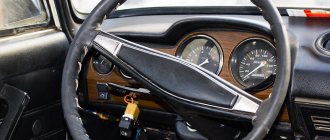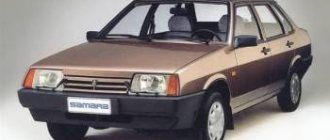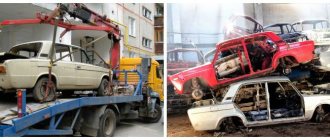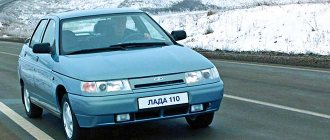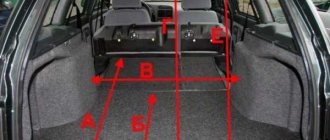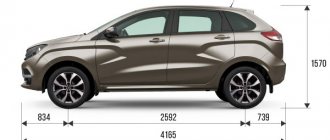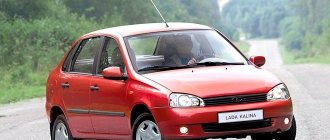I took the car for spare parts, I took off everything I could, I wanted to sell it as metal, but there are no scales to weigh the body. If anyone knows, tell me how much the bare body of a VAZ 2110 weighs (without doors, trunk lid, hood, rear and front beams, A-pillars, and fenders) in advance thanks a lot!
Comments 16
330 kg turned out
I also sold it without a roof for 2k, with the price of metal being 6.5r/kg
everywhere? Some of us also have 5. There are also 7, but there the scales are twisted too much))
yes, if you take the current to the city
at a price of 7-8 rubles per kg they give about 2-2.3 k for a bare body. cut into pieces. This makes it easier to transport and weigh
If the body is alive, they can buy a quarter or anyone who needs anything (left glass, roof, rear part), and this is more expensive than scrap metal
It’s a long time and he’s bothering me...
they seem to cost more in pieces)
from a penny entirely without doors and hood - pulled 330 kg, from 10 I don’t know
They accept bodies, don’t listen to anyone, you’ll just have to look where. I personally went there to hand over the metal - there was a gantry crane and scales on a hook, and workers there cut the bodies with a cutter and loaded them into the wagons right away. In small caricatures this may not be accepted, but in general they may require some kind of paper, a passport 100%. I didn’t hand over the body itself, a friend had been carrying a penny for a long time, he didn’t even ask about the weight.
Domestic cars are always popular among car owners. The main reason is availability in terms of price, as well as inexpensive maintenance. Back in Soviet times, VAZ earned a reputation as a high-quality and reliable car.
True, over time, drivers began to trust VAZ cars less, but this does not apply to older models like 2112 and those that came before it. The VAZ-2112 car began to be produced in the late 90s. And he still enjoys trust.
Weight of VAZ 2110 bodies
The VAZ 2110 2110 1.5 MT sedan is equipped with one of the lightest bodies, its weight is 1010 kg.
Model body weight:
Body weight of modifications of the VAZ 2110 sedan (1995 – 2009):
- 1010 kg, 1020 kg, 1100 kg, 1330 kg.
Model body information:
The body of the VAZ 2110 is load-bearing and has a closed power structure, that is, it forms a closed contour (due to the presence of a roof) and brings together all vertical power elements.
All parts of the VAZ 2110 body are made by stamping from low-carbon, thin-sheet steel (thickness from 0.7 mm to 0.9 mm), heavily loaded parts are made from sheet 1.2 mm thick.
Important: according to the technical documentation, one of the heaviest bodies is the VAZ 2110 21109 Consul 1.5 MT sedan, its weight is 1330 kg.
Other names:
Until 2014, the VAZ 2110 model was assembled under license from AvtoVAZ vehicle kits at the Bogdan Corporation automobile plant under the Bogdan-2110 brand.
Subtleties of the model range:
The model is equipped with an electronic engine control system, a diagnostic unit (on-board computer), power steering, electric windows, and a new body painting technology is used.
Years of production Years of production: 1995-2007.
Body dimensions: checking car geometry
Repair work to restore the VAZ 2101 body should begin with checking its geometric dimensions.
The geometry of the body can be disrupted as a result of various mechanical influences, loss of rigidity and elasticity of rusty structural elements. To ensure that the vehicle's geometry corresponds to its original parameters as a result of restoration work, check the control points specified in the vehicle's operating instructions. How many mm of taper is allowed will be answered by the manufacturer, who determined the unevenness of the gaps to be 1.5 mm.
If the tolerances for the front elements of relatively fixed structures are more than 2 mm, then restoration of the geometry of the frame is required, which is carried out in auto repair shops using special equipment - a slipway. If there are no serious discrepancies in the geometric dimensions, measured and certified, you can proceed to the next step - welding work.
How much does a VAZ 2112 16 valve engine weigh?
| Years of manufacture | 1997 – 2004 |
VAZ 2112 engine weight , kg | 127 |
| Overall dimensions of engine 2112 (LxWxH), mm | — |
| Engine oil | 5W-30 / 5W-40 / 10W-40 / 15W40 |
| How much oil is in the engine, l | 3.5 |
Hello, my name is Evgeniy Sokolov. Since childhood I have been fascinated by cars, especially how they work
And I received the appropriate technical education. In my blog I write reviews of models, technical characteristics and operating experience of various industrial and agricultural special equipment.
Source
What is firmware
This is a special program that contains a certain set of corrections and calibrations, which allows you to control the engine in automatic mode. It also uses a set of readings from different sensors:
- mass air flow;
- crankshaft position;
- detonation;
- throttle position.
Based on these sensors, the firmware can produce hundreds of calibration options. All this is necessary for the coordinated and elastic operation of the engine at different speeds. The firmware is “flooded” in the engine. It is the ECU that determines how much fuel mixture and what ratio needs to be supplied to a particular cylinder in a given period of time.
Chip tuning is a software change in the VAZ firmware by replacing some settings with more “advanced” ones. It is worth noting that such firmware can be built for different tasks. So, one program is designed for fuel economy, the other for high power and torque.
Bodies and what they are like
ATTENTION! A completely simple way to reduce fuel consumption has been found! Don't believe me? An auto mechanic with 15 years of experience also didn’t believe it until he tried it. And now he saves 35,000 rubles a year on gasoline! Read more"
As you know, the body on the “ten” is load-bearing and repeats the basic design of any modern passenger car. Today it is customary to talk about several types of bodywork. The frame and supporting body are considered the main ones.
The difference between frame and load-bearing
All the main components of the car are located on the frame; it serves as a support and is itself fixed to the wheels of the car by means of suspensions. If you pay attention to trucks, then the frame can be seen with the naked eye, and thus you can draw appropriate conclusions about its structure. In “passenger cars” there is no frame, or it would be more accurate to say that on some passenger cars the frame-body assortment forms a single whole, called the body.
Frameless bodies, which include the metal frame of the VAZ 2110, are made in such a way as to withstand the mass of numerous heavy components. For this purpose, the body floor is well reinforced, and most of the overall parts are made of materials with a lightweight base.
On frameless bodies, the role of the frame is performed by the spars. They can be said to be responsible for the massiveness of the entire body structure. From time to time, these components are subjected to unplanned and shock loads that change very quickly in different directions. This operating scenario cannot have a positive effect, and over time, the welding points break, the bolts become loose, and the solidity of the entire body structure weakens.
The car body also feels the load from a running engine. It vibrates strongly, although the engine itself and the cylinders are designed to absorb some of the vibrations. To minimize the effects of vibrations on the body, manufacturers use special cushions or dampers, as well as washers made of dense rubber.
Note. The effect of these pads can be clearly determined by monitoring the operating unit with the hood open. The engine “growls” and shakes, but the body doesn’t care.
The most important task of a frameless car body is to transport luggage and passengers. At the same time, the machine must also provide major protection. The number of people transported and the weight of the permissible load are determined by the designers responsible for the layout and other parameters of the body.
If you imagine the frame of a “car” in the form of its components, then its main parts are three main zones, implying the trunk, the passenger compartment and the front. The finished look of the solidity of the frame is given by its hinged parts or “plumage”, which includes various panels.
Body types of the “tenth” family
The difference in body types, again, is associated with what one or another model is intended for. The car may be intended for off-road travel, and then it will be designed as a crossover or a full-fledged all-terrain vehicle, or it may be intended only for city driving.
Note. The body of the VAZ 2110 is a typical sedan. Models associated with the “ten” already have other body types: 2111 – station wagon, 2112 – 5-door hatchback, 21123 – coupe or 3-door hatchback.
It will be useful to know that over the entire production period of the 2110 model, VAZ creates many variations of this sedan. In particular, the Consul limousine, with an even longer wheelbase, deserves attention.
The design of the sedan began immediately after the VAZ 2108 became obsolete, when the plant decided to replace the project. But the release of the “ten” was not yet imminent. The fact is that the designers made many revolutionary improvements that significantly increased the cost of the project. Due to the economic crisis that reigned in the country at that time, the project was moved forward several years, and only in 1995 mass production of the “ten” began.
The sedan is the classic and most popular body style of modern cars. The interior includes 2 rows of seats and usually accommodates 4-5 people including the driver. The luggage compartment in sedans is properly separated from the interior.
For many, to this day, the question of the merits of the VAZ 2110 car is somewhat controversial. It is clear that it cannot compare with foreign cars, but the presence of “ten” running on the roads of our country speaks volumes.
Dimensions and how much it weighs
The body length of the “ten” sedan is 4265 mm, which is only slightly less than the “universal” dimensions. This length looks the most organic not only among the models of the “tenth” family, but also in VAZ as a whole.
We also note that the length of the “ten” is 6 cm longer than the length of the only “Samarov” sedan - VAZ 21099. The same goes for other parameters:
- The longitudinal distance between the wheel axles is 3.2 s longer;
- Body height is 1.8 cm higher;
- Ground clearance is 5 cm higher.
But both gauges are the same for “99” and “tens”. In addition, both models have similar gearboxes and engines. But still, in general, the technical characteristics of the “tens” and “99” are different. The “Ten” is able to achieve better speed and demonstrate enviable maneuverability on the road compared to the “99”, precisely due to the body design, made with modernizations and significant improvements. In particular, these are smooth body lines and completely modernized control systems.
Due to the greater length, which experts called “ideally sufficient,” the trunk of the VAZ 2110 sedan becomes very spacious. Its usual layout is 415 liters, which is already the envy of competitors.
The large volume of the luggage compartment allows you to transport by car not only the essentials, including a spare wheel and tools, but also many additional things. If you remove the rear seats, turning the rear of the cabin into an additional trunk, you can transport up to 1270 liters of cargo.
The wheelbase of the “ten” is 2492 mm, which is also very good. If we add to this the length of the trunk - 944 mm, then on a long journey, if you have a sleeping mattress, you can make a quite comfortable bed.
VAZ's new sedan is wider, taller and longer, but also heavier than the standard family of cars (1020 kg). This was to be expected, because the designers sought to increase the interior space, thereby increasing the comfort of people sitting in the cabin.
Features of car recycling
Before you scrap your car, you should familiarize yourself with the principles of this procedure. The average weight of a vehicle is 1000 kg. If the entire car can be recycled, the collection point will deduct 30% for clogging. The latter includes all non-metallic elements, pollution, etc.
Let's consider how much a car for scrap metal weighs using the example of a VAZ 2105. The weight of the latter is 955 kg. Thus, taking away the blockage, we get about 660 kg. You should also take into account the price of scrap, which differs depending on the city. As a rule, in megacities, the number of rubles received for a car will significantly exceed the amount earned in a similar organization in a small locality.
Before calculating the profit from a scrapped car, you need to take into account transportation costs. If the car is a pile of metal, you need to take care of a tow truck. If there are spinning wheels and functional steering, the car can be transported in tow. Then, this expense item will not be so significant. Therefore, in order to calculate how much a Zhiguli costs when scrapped, it is not enough to know how much a VAZ 2109 or 21099 weighs for scrap metal (915 kg). It is necessary to take into account the features of recycling and the requirements of collection points. It would be useful to know the average cost of scrap metal in the region. Additional awareness will allow you to avoid fraud on the part of unscrupulous receivers.
Despite the fact that disassembling a car is a labor-intensive procedure, many owners still decide to take this step. Thus, you can sort ferrous and non-ferrous metals and hand them over separately, removing the good parts. From an economic point of view, the procedure will be justified.
Let's consider how much a VAZ 2106 weighs for scrap metal based on individual significant structural elements:
It should be noted that dismantling machine parts requires a lot of time and certain skills. In the absence of the latter, it would be more rational to recycle it entirely.
Source
VAZ 2110 body diagram and dimensions
| Body length including bumpers, cm | 426,5 |
| Wheelbase length, cm | 249,2 |
| Height when loaded, cm | 142 |
| Distance from the front axle to the end of the bumper, mm | 829 |
| Distance from the rear axle to the end of the bumper, mm | 944 |
| Body width, cm | 168 |
| Vehicle weight, kg | 1020 |
| Body weight, kg | 260 |
| Distance between the tips of the side mirrors, cm | 187,5 |
| Front track, cm | 140 |
| Rear track, cm | 137 |
| Maximum ground clearance (empty car), cm | 18 |
| Ground clearance (car loaded and driver), cm | 17 |
| Minimum ground clearance (driver, 4 passengers and luggage), cm | 16,5 |
design features of the gearbox of cars VAZ 2108, VAZ 2109, VAZ 21099
Gearbox design features
Depending on the vehicle configuration, a four- or five-speed gearbox can be installed, combined with a differential and final drive, the gear ratio of which can have several values (see “Technical characteristics of vehicles”). The input shaft 23 (Fig. 5.7) is made in the form of a block of drive gears, the drive gears are in constant engagement with the driven gears of all forward gears. The drive gears are located on needle bearings on the secondary shaft 33. In addition to them, two synchronizers are installed on the secondary shaft of the gearbox. The main gear drive gear is made together with the secondary shaft. The differential is two-satellite. The preload in the differential bearings is adjusted by selecting the thickness of the ring 4. The driven gear 34 of the main gear is attached to the differential box flange. The gearbox control drive consists of gear shift lever 38 (Fig. 5.8), ball joint 36, rod 34, gear shift lever 19 and gear selection and shift mechanisms. A lever 20 is attached to the inner end of the rod 19, which acts on the three-arm lever 11 of the gear shift mechanism. This mechanism is made as a separate unit and is attached to the plane of the clutch housing 23. Two axes are fixed in housing 1 (Fig. 5.9) of the gear shift mechanism. On axis 4 there is a three-arm gear shift lever, two locking brackets 8 and 13 and a bushing 12. Another axis 3 passes through the hole in the hub of the locking brackets, securing them from turning. The arm of the gearshift lever 2 is used to engage forward gears, the arm of the lever 11 is used to engage reverse gear, and the third arm is used by lever 20 (see Fig. 5.8) of gearshift lever 19. A lock 9 is mounted in the hub of the gear shift lever (see Fig. 5.9). A fork 10 for engaging reverse gear is installed on axle 7.
Rice. 5.9. Gear shift mechanism:
1 — gear shift mechanism housing; 2 — gear shift lever (forward); 3 — guide axis of locking brackets; 4 — gear shift lever axis; 5 - spring; 6 — retaining ring; 7 — reverse fork axis; 8.13 — locking brackets; 9 — gear shift lever lock; 10 — reverse fork; 11 — gear shift lever (reverse); 12 - thrust bushing For a five-speed gearbox, the primary and secondary shafts at the exit from the crankcase are extended. On this part of the shafts there are drive 8 (Fig. 5.10) and driven 2 gears of the fifth gear and its synchronizer 3. For a five-speed gearbox, bushing 12 (see Fig. 5.9) is not installed in the gear shift mechanism. Gearboxes are available with different final drive ratios. To distinguish the secondary shafts, grooves are machined on their gear rims: two on the left (the shaft crown is located to the right of the observer) - for a seventeen-tooth rim, one on the left - for a sixteen-tooth rim, one on the right - for a fifteen-tooth rim. The driven gears of the final drive are marked with a gear ratio (for example, 65/15). To distinguish gearboxes by their final drive ratios, they are marked with paint. The marking is applied to the upper part of the gearbox housing: 01 - for gear ratio 3.9; 02 - for gear ratio 4.1; 03 - for gear ratio 3.7; 00 - for gear ratio 4.1 five-speed gearbox.
Rice. 5.10. Five-speed gearbox rear:
1 — driven gear of the fourth gear of the secondary shaft; 2 — driven gear V of the secondary shaft transmission; 3 — 5th gear synchronizer; 4 - secondary shaft; 5 — rear cover of the gearbox housing; 6 — breather; 7 - input shaft; 8 — drive gear of the 5th gear; 9 — thrust plate for fastening bearings; 10 - gearbox housing USEFUL TIPS
The manufacturer does not give clear recommendations on gearbox oils. Either motor oil or various transmission oils are recommended. Therefore, decide which oil to use depending on the operating conditions of the car. If a VAZ 2108, VAZ 2109, VAZ 21099 car is operated mainly in a big city with frequent gear changes, then use motor oil, since in this case a relatively long service life of the synchronizers is ensured. If you mainly drive on highways at high speeds, but with relatively infrequent gear changes, it is better to use transmission oil, which provides an increase in the life of gears and bearings while slightly reducing the durability of the synchronizers. When filling the gearbox, try to fill it with a little more oil (about 100 ml) than recommended by the manufacturer. This will provide better operating conditions for the fifth gear bearing, which is located high in the crankcase and is lubricated only by splashing.
four-speed gearbox
Rice. 5.7. Four-speed gearbox:
1 — gearbox housing; 2 — filler and control hole plug; 3 - drain plug; 4 — adjusting ring; 5 — left front wheel drive; 6 — driven gear of the 1st gear of the secondary shaft; 7 — synchronizer clutch for 1st and 2nd gears with reverse gear; 8 — driven gear of the second gear of the secondary shaft; 9 — retaining ring; 10 — thrust half-ring 1 — driven gear of the third gear of the secondary shaft; 12 — synchronizer clutch hub for 3rd and 4th gears; 13-driven gear IV transmission of the secondary shaft; 14-needle bearing of secondary shaft gears; 15 — thrust washer of the 4th gear gear; 16 — ball bearing of the secondary shaft; 17 — rear cover of the gearbox; 18 — ball bearing of the input shaft; 19 — breather; 20 — synchronizer blocking ring; 21 — sliding clutch for synchronizer of 3rd and 4th gears; 22 — retainer block; 23 - input shaft; 24 — retainer ball; 25 — fork of the sliding clutch for the synchronizer of 3rd and 4th gears; 26 — roller bearing of the input shaft; 27 — clutch release fork lever; 28 — clutch release fork bushing; 29 — clutch housing; 30 — clutch release fork; 31 — clutch release bearing; 32 — roller bearing of the secondary shaft; 33 - secondary shaft; 34 — driven gear of the main gear; 35 — tapered roller bearing of the differential; 36 — differential box; 37 — satellite; 38 — retaining ring of the side gear; 39 — semi-axial gear; 40 — speedometer drive gear; 41 — right front wheel drive; 42 — speedometer drive; 43 — satellite axis; 44 — retaining ring of the satellite axis; 45 — protective cover of the gear shift drive hinge
gearbox control drive
Rice. 5.8. Gearbox control drive:
1 - secondary shaft; 2 — fork for shifting 1st and 2nd gears; 3 — fork for shifting III and IV gears; 4 — 5th gear shift fork; 5 — rod of the 5th gear shift fork; 6 — retainer ball; 7 — clamp spring; 8 — clamp cover; 9 — guide axis of locking brackets; 10 — reverse light switch; 11 — three-arm gear shift lever; 12 — reverse fork lock plug; 13 — reverse fork; 14 — gearbox housing; 15 — blocking brackets; 16 — gear shift mechanism housing; 17 — gear shift lever axis; 18 — gear shift lever spring; 19 — gear shift rod; 20 — gear shift rod lever; 21 — fork rod for shifting III and IV gears; 22 — rod for shifting 1st and 2nd gears; 23 — clutch housing; 24 - bushing; 25 — rod seal; 26 — conical screw for fastening the hinge; 27 — protective cover of the hinge; 28 — housing of the gear shift drive rod hinge; 29 — hinge bushing; 30 — hinge axis; 31 — hinge tip; 32 — gear shift drive rod clamp; 33 — gear lever housing; 34 — gear shift drive rod; 35 — protective cover of traction; 36 — ball joint of the lever; 37 — spherical lever finger; 38 — gear shift lever; 39 — lever axis; 40 — lever axis bushing; 41 — locking bracket
possible gearbox malfunctions, causes and methods for eliminating gearbox malfunctions
| Cause of gearbox malfunction | Method for troubleshooting gearbox |
| Gearbox noise | |
| Wear of gear teeth Wear of bearings Insufficient oil level | Replace worn parts Replace worn bearings Add oil. If necessary, replace damaged or worn seals |
| Difficulty shifting gears | |
| Incomplete release of the clutch Deformation of the gear shift control rod or torque rod Loosening of the screws securing the hinge or gear selector rod lever Incorrect adjustment of the gear shift drive Wear or breakage of plastic parts in the gear shift drive | See subsection. “Clutch” Straighten the rods or replace the rods Tighten the screws (see “Gearbox”) Adjust the gear shift drive Replace damaged parts |
| Spontaneous gear shutdown | |
| Damage or wear of the ends of the synchronizer teeth on the gear and clutch Increased vibrations of the power unit on the supports due to cracks or delamination of rubber on the rear supports Lack of gears due to incorrect adjustment of the gear shift drive or incorrect installation (tension) of the protective traction cover | Replace worn and damaged parts Replace damaged parts Adjust the drive (see “Removing and installing the gearbox”). or adjust the traction cover |
| Noise (“crackling”) when shifting gears | |
| Incomplete release of the clutch Worn locking ring of the gear synchronizer | See subsection. "Clutch" Replace the locking ring |
| Oil leak | |
| Wear of the input shaft oil seals, constant velocity joint housings, gear selector rod or speedometer drive shaft seal. The crankcase or box cover is loose or the sealant under the box cover or between the box housing and the clutch housing is damaged, the drain plug is loose. | Replace oil seals, seal Replace sealant, tighten bolts and nuts, tighten drain plug |
- Author: admin
Rate this article: Share with friends! Related posts:
repair, disassembly and troubleshooting of gearbox parts of VAZ 2108, VAZ 2109, VAZ 21099
replacing gearbox seals on VAZ 2108, VAZ 2109, VAZ 21099 cars
repair of the gear shift mechanism on VAZ 2108, VAZ 2109, VAZ 21099 cars
Tens body care and repairs
The overall body of the “ten” looks more reliable, durable and resistant to corrosion. All-metal and partially galvanized, it comes off the assembly line already treated with anticorrosive, ready for harsh operating conditions.
On the other hand, we must pay tribute to our car owners, who are accustomed to finishing everything with their own hands. In particular, while remaining adherents of the domestic automobile industry, they turn a blind eye to the differences and shortcomings of technology in comparative terms and take additional care of the body so that it serves for many years without problems. Russian car owners almost always add special protection to the standard anti-corrosion treatment.
Preventative work specifically involves tinting the bottom of the car, treating sills and fender liners with Movil.
Note. We can say with confidence that among the “dozens” with high mileage, even today you can find examples that have been so well cared for by the owner that they look like new.
People's love for the “ten” is also symbolized by the succinct names given to the car by amateurs. “Matryoshka”, “pregnant antelope”, “chubby” - all these nicknames, albeit with some degree of irony, speak of love for the car. If at first the unique, new design of the VAZ model raised questions, then over time the angular shapes of the “bow” and “stern” became familiar.
Here are the preventive works that are usually carried out on the body of the “tens” throughout the entire operational period:
- Caring for paintwork;
- Lubrication of metal components of the body;
- Cleaning of technical holes;
- Periodic anti-corrosion protection of the body as a whole and treatment of hidden areas;
- Noise insulation;
- Sealing.
To protect the original paintwork of the body, you must be able to select the appropriate polishes and follow the rules for their application. In addition, the VAZ 2110 must first be washed when the car is new, only with cold water, and for treating paintwork, use polishes that do not contain abrasives.
Caring for the paintwork of a car with a 3-5 year mileage implies a different scenario:
- Use products for weathered surfaces (they contain a certain amount of abrasive).
Accordingly, for a body older than 5 years:
- Use products specifically designed for aged surfaces.
It is also recommended to polish the body in small areas by hand using clean flannel. This is done to prevent the polish from drying out during application.
Polishes PMA-1 and PMA-2 have proven themselves well.
More good tips on the body in general:
- Do not store the car under rubber covers;
- Do not place rubber objects on painted surfaces (they will leave stains that are almost impossible to remove);
- Protect the paintwork from contact with alkalis, brake fluid and other chemicals that can destroy the coating.
It is recommended to lubricate rubbing parts and body elements from time to time in order to increase the durability of the metal frame. So, this should be done at least every 15 thousand km of the car or once a year.
Here's how and where to do it:
- Apply engine oil to door hinges;
- Apply CV joint grease-4 or Molikot to the limiters;
- Lubricate door locks with FIOL-1;
- Apply VTV-1 aerosol lubricant to the lock cylinders;
- Use the same product to lubricate the hinges and springs of the fuel tank hatch;
- Lubricate the hood lock with FIOL-1;
- Use the same tool to lock the trunk lid.
Anticorrosive treatment also needs to be given great attention. Hollow parts of the body and parts located in the lower part are most susceptible to the negative effects of rye (they are constantly exposed to moisture and dirt due to their close location to the road surface).
It has proven itself well for protecting the metal components of the body from corrosion. As for the treatment period, it is recommended to carry it out every year.
Due to the complexity of the work, it is recommended to treat hidden body cavities with anticorrosive agents at a service station. If the garage has the appropriate tools and equipment, then the process is as follows:
- The car is placed on a jack;
- The casing and all components that interfere with access to hidden cavities are removed;
- The holes are washed until clean water flows out;
- The surfaces are thoroughly dried, and all areas where the anticorrosive is applied are blown with compressed air.
The table below shows hidden cavities and how to apply anticorrosive.
Competitors
Fiat Albea
Fiat Albea (2002–05)
The Fiat Albea is a reliable four-door sedan that is very cheap and unpretentious. On the secondary market you can find versions with an engine capacity of 1.4 and 1.6 liters. Albea's body is galvanized, so there are cars with whole metal. This option is perfect for city driving. If you are considering buying a VAZ 2112 specifically for city driving, then the Fiat Albea will be an excellent replacement. Comfort, like any foreign car, will be higher than that of the Lada, there is air conditioning. The build quality is also higher, the sound insulation is satisfactory.
LADA 2114
Lada Samara 2114 (2001–13)
VAZ 2114 is the older sister of the “twelfth”, which is also not intended for high-speed driving and has very mediocre handling. This is a great option for fishing trips. The car, due to its lighter weight, drives perfectly through the fields, it can be rocked and pulled out of any large puddle or hole.
The “fourteenth” does not have a hydraulic booster, but the steering wheel nevertheless rotates well. The 14 is lighter, making it easier to ride off-road, but the lighter weight means less stability on the trail. In strong winds and on sharp turns, the car easily lifts off the ground.
This car, like the 12th model, is suitable for beginners and young people who do not have money for a more expensive and high-quality car.
ZAZ Chance
ZAZ Chance Hatchback (2009–14)
This is another representative of the ultra-budget segment. Like all other domestically produced machines, it is characterized by low quality and low cost. Its interior is a little more comfortable and visually pleasing than that of the VAZ.

